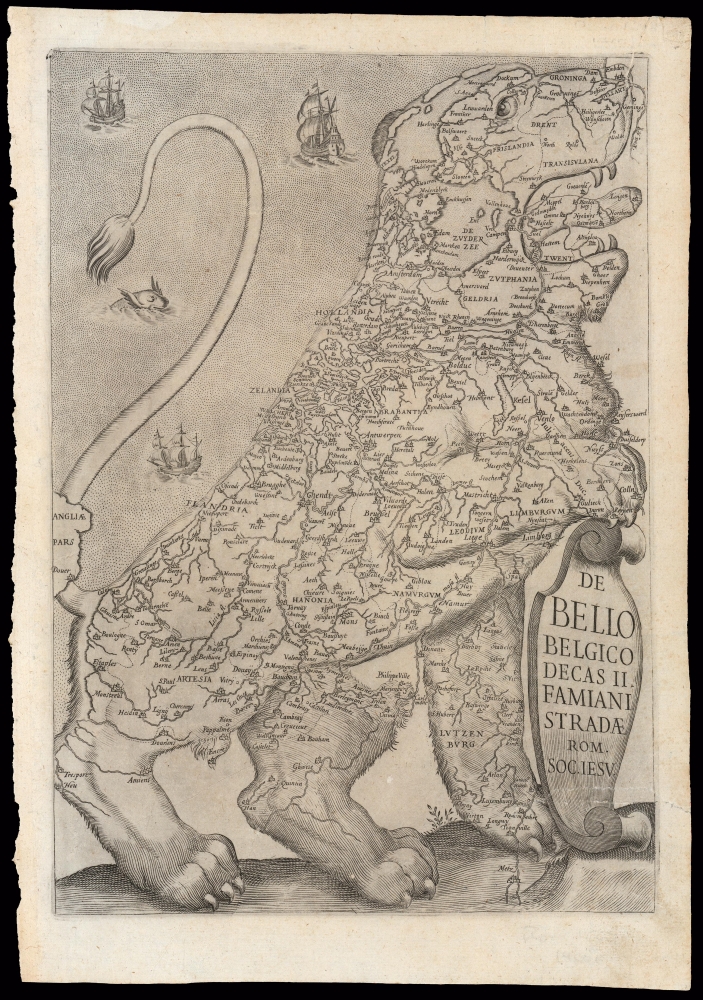This item has been sold, but you can get on the Waitlist to be notified if another example becomes available, or purchase a digital scan.
1632 / 1647 Famiano Strada Leo Belgicus Map of the Netherlands in its first, Rome Edition
LeoBelgicus-strada-1632
Title
1632 (undated) 12.5 x 8.5 in (31.75 x 21.59 cm) 1 : 1750000
Description
A Closer Look
The map presents the seventeen provinces of the Netherlands, reaching from Gronigen in the north, into southern regions now considered part of France (Amiens forms part of a hind leg, and Metz is just below the left front paw). The Dutch coastline forms the lion's back, with its tail lashing over the sea. The geographic details of Strada's map are largely consistent with those of von Aitsing's 1583 map, which is agreeable with the contemporary maps of Ortelius.The waters of the North Sea are elegantly stippled, and sailed by three finely-engraved ships. A sea monster lurks in the curl of the lion's tail. The lion's throat and chest (and the western limit of the map) is roughly described by the course of the River Rhine.
The Leo Belgicus
The first appearance of a Leo Belgicus was in Michael von Aitzinger's 1583 history of the Dutch Revolt. The Austrian von Aitzinger was no partisan firebrand. He explained in his text that this novel map was introduced 'in such a form as it has never been seen before, in order that you will better understand the description of the various parts it comprises'. First and foremost, this was a representation of the seventeen provinces of the Netherlands as a single unit; the use of the lion as a unifying visual element derived from the fact that the heraldry of most of those seventeen provinces already employed leonine symbolism. Thus, von Aitzinger's purpose was to employ an effective visual mnemonic. Indeed, he was at great pains in both the map and its attendant history to exhibit a scrupulous neutrality - 'you will find everything more truthful and acceptable since we personally observed and verified all the facts on both sides.'Italian Jesuit Famiano Strada (1572 - 1649) was tasked by his patron, the Duke of Parma, to write a history of the Dutch Revolt in 1617. To do so he was given access to the astonishing private archives of the House of Farnese which contained relevant correspondence of princes, ambassadors, and even spies. All of Strada's sources represented the Catholic, Spanish perspective on the war; so like von Aitzinger, his use of the Dutch Lion is unlikely to have been propagandistic. It is telling that Strada's work, while translated into English, Spanish, Italian, and French, would never be printed in a Dutch edition.
Strada's work became a monumental undertaking, planned in three 'decades'. The first of these (covering the years 1559 - 1579) was published in 1632; the second, (covering 1579 - 1589) was printed in 1647. A third decade is said to have been blocked from publication by Spanish authorities.
Each of the two published decades of Strada's history featured this Leo in their title pages. The title cartouche in the 1632 first decade, reads De Bello Belgico Decas Prima. The same plate was used for printing the title of the second decade, with the title amended to De Bello Belgico Decas II with no other changes. None of the later editions of Strada, printed in Antwerp and elsewhere, would employ this plate, instead using smaller-format maps.
Publication History and Census
This map was engraved - anonymously, but perhaps by François Collignon or Guilielmi Baur - for inclusion in the 1632 first edition of Strada's De Bello Belgico Decas Prima, published in Rome by Francesco Corbelletti. This second state of the map was amended for the 1647 Decas II of Strada's work, also published by Corbelletti. While Strada's history is well represented in institutional collections, this second state of the first edition Strada is only listed once in OCLC, in the Bayerische Staatsbibliothek.CartographerS
Famiano Strada (1572 - 1649) was an Italian Jesuit historian, particularly of the early part of the Eighty Years' War, from the abdication of Charles V in 1556 to the capture of Rheinsberg in 1590. He was born in Rome, entering the Jesuit order as a young man and teaching rhetoric in the Roman College early in the seventeenth century. In 1617 he was tasked by Ranuccio I Farnese, Duke of Parm to write a history of the war in the Netherlands, access which afforded Strada a range of sources including the letters of royalty, ambassadors, and even spies; Strada would throughout his work characterize these as 'state secrets.' The publication of his history consumed Strada's life: the first volume of the work, describing the period between 1559 and 1597, would be published in Rome in 1632; the second covering 1579 to 1589 saw print in 1647. A third volume appears to have been planned, but its publication was prevented by Spanish authorities, who perhaps considered more contemporary revelations to be detrimental to Spanish policy. The earlier volumes would themselves appear in many editions, some translated into English, Italian, French and Spanish. More by this mapmaker...
Michael von Aitzing (c.1530 - 1598) was an Austrian nobleman, diplomat, and historian. His most notable history, the 1583 Novus de Leone Belgico, described the early part of the Eighty Years' War, and introduced the first cartographic representation of the Low Countries as 'Leo Belgicus.' His other works included a genealogical volume codifying the principles of a genealogical numbering system, called an Ahnentafel, which are still in use today. Learn More...

